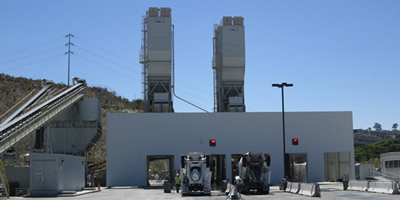FIRST PLACE – VULCAN MATERIALS CO., MISSION VALLEY READY MIX PLANT, SAN DIEGO, CALIF.
At its peak, the 250-acre Mission Valley complex comprised aggregate mining plus ready mixed concrete and hot mix asphalt production. As reserves were depleted, portions of the property were redeveloped for residential and commercial use. Ready mixed production is the only process remaining, and will eventually be surrounded by housing on three sides.
The fully paved plant is designed to be aesthetically and environmentally sound yet produces concrete at a higher yards-per-hour rate than most ready mixed operations. The entire plant, including parking areas, material storage, and maintenance shop is surrounded by landscaped berms approximately 30 ft. high.
Mission Valley utilizes a site-specific Environmental Management System based on a continuous, three-tier auditing and improvement plan. Staff conduct written daily inspections on all facets of environmental performance including air quality, storm water management, and hazardous materials storage.
Managers and staff approach process and other wastes with an “all resources shall be reused” attitude. Smaller amounts of returned concrete are placed into a reclaimer, where the water and fine and course aggregates are separated and put back into new concrete mixes. A reclaimed water system plumbs right back into the plant to supply partial batch volumes. Medium sized loads of returned concrete are used to fabricate concrete blocks, while larger quantities are allowed to harden, then brought to an offsite crushing and sizing facility, yielding crushed concrete aggregates or base materials.


SECOND PLACE – MARTIN MARIETTA MATERIALS QUIVAS CONCRETE PLANT, DENVER, COLO.
Located on the edge of downtown Denver in once solidly industrial area, the plant is now within blocks of a residential neighborhood, elementary school, college campus, city park, and a commuter light rail line station. Its height also makes it visible from a long distance, requiring aesthetic treatments along with tight pollution controls.
The Martin Marietta Rocky Mountain Region staff has a variety of tools and procedures for regulatory compliance and documentation of related practices. An inspection-ready binder at the plant contains all required permits, documentation and monthly reports. A checklist is posted so plant management and staff know on a daily, monthly and yearly basis what is required for the operation. Permit files are also located in an electronic land and environmental data management system accessible to personnel who need to track various documents. The system is programmed to alert the environmental manager of upcoming permit renewals.

The Quivas plant is equipped with three collection basins for process water. The first is next to the main entry gate, collecting all washdown water from trucks after they are loaded. It is divided to allow the solids to separate from the water, and accommodate a loader for clean out. Captured water is pumped back to the main washout area. Another catch basin at the secondary entry gate collects any process water from the loading area, as well as main washout pit overflow. It pumps the water back to the settling side of the main washout area, which is designed to collect all process water from the site, settle out the solids, and enable reuse.
In order to reduce water contamination and process water volume, the site was changed to physically separate as much stormwater from production and washout areas as possible. A small berm was constructed just outside of the area used to wash trucks; it isolates approximately 1/3 of the property from the process water. A separate basin was installed to collect the storm water and allow for periodic testing as well as to control the discharge of the water leaving the property.
THIRD PLACE – CALPORTLAND CO. DUWAMISH READY-MIX PLANT, SEATTLE, WASH.
Glacier Northwest, Inc., dba CalPortland, is the Pacific Northwest’s largest ready mixed producer, with roughly 450 employees in the Washington division. It operates 14 concrete plants, a cement distribution terminal, plus four sand & gravel or quarry sites. With parallel central mixed units, the Duwamish Plant has 70 drivers, production staff and truck maintenance shop mechanics.
All CalPortland plants are maintained to a high level of cleanliness; however, extra attention is paid to this effort at the Duwamish site, starting with fully paved area. Plant personnel make every effort to maintain a clean and aesthetically pleasing operation. Pavement is cleaned daily and all debris and garbage kept in appropriate storage containers. Housekeeping is critical to reduce potential impact to the Duwamish River and fragile marine environment along the rear of the property.
Environmental stewardship and reaching beyond compliance are core beliefs at CalPortland, where management expects unwavering compliance with all environmental regulatory requirements and trains employees to perform accordingly. By targeting high environmental standards and expecting the same from business partners, management notes, CalPortland separates itself from competitors.



The producer has completed a number of Duwamish plant improvements, including both physical and personnel changes supporting objectives outlined in the corporate environmental statement, which calls for a) institution of a training program that encompasses all site employees and drivers and extends the policies practiced at the plant site to all places drivers deliver product; b) fully contained and paved process water area with an advanced treatment system using hydrochloric acid to control pH and achieve low turbidity and total suspended solids levels; c) zero tolerance policy for material spillage from barges delivering materials to the site, backed with an upgrade to the unloading conveyor; d) landscaping along the riverbank friendly to the existing ecosystem and migrating fish species; e) aggregate recovery system which separates and cleans sand and gravel from returned concrete for re-use, with processing levels now hovering 2,000 tons; and, f) slurry recovery system maximizing re-use of cement in concrete production.
